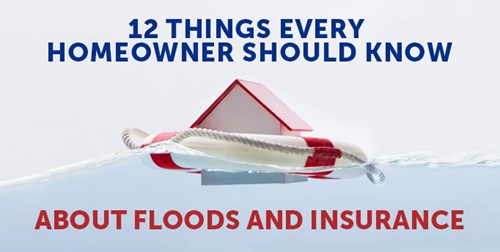In 2017, Texas was devastated by Hurricane Harvey. No one anticipated the unprecedented flooding that scientists later described as a "1,000-year flood event." Hurricane Harvey claimed 82 lives and incurred an estimated $125 billion in damages. More than 15,500 homes were destroyed and another 273,000 homes were damaged - many of which were not covered by flood insurance.
According to the Federal Emergency Management Agency (FEMA), 90 percent of all natural disasters in the U.S. involve flooding. Floods are the most common and costly natural disaster, and you don't have to live in a floodplain to experience flooding. Homeowner's insurance covers many weather-related claims, but it does not cover flooding. Having flood insurance can mean the difference between recovery and financial devastation.
Before disaster strikes, it's important to know your risk of flooding, understand what your insurance does and doesn't cover, and plan accordingly. Here is a list of 12 things every homeowner should know when it comes to floods and insurance.
- Homeowner's insurance does not cover flooding. Most homeowner's insurance policies cover damage from fire, hail and windstorm. Water damage caused by a leaky roof or a busted pipe is usually covered, but flooding is never covered.
- Flood insurance is offered through the federal government. FEMA's National Flood Insurance Program (NFIP) offers flood insurance to homeowners, renters and businesses in NFIP-participating communities, but you must purchase it through a private insurance professional.
- Federal aid doesn't cover everything. Only half of all natural disasters trigger federal assistance. While some grants are available, most federal aid is offered as low-interest disaster loans that must be repaid. You don't have to repay money received from flood insurance claims.
- Typically, there's a 30-day waiting period before you're covered. You can purchase flood insurance at any time, but except for a few exceptions, it doesn't take effect until after the 30-day waiting period.
- Flood maps change. If you didn't live in a flood zone when you bought your home, there's a chance you could now - or will in the future. Check your flood zone status so you can plan accordingly.
- You don't have to live in a flood zone to experience flooding or purchase flood insurance. Flooding can occur anywhere, for a variety of reasons. According to FEMA, individuals living outside of high-risk flood zones file more than 20 percent of flood insurance claims.
- You may be required to carry flood insurance. Lenders can require any borrower who has a federally insured mortgage to carry flood insurance. If you're required to have flood insurance, and fail to purchase or maintain adequate coverage, your lender can purchase it on your behalf and bill you for it, often at a higher rate. Also, if a homeowner accepts Federal disaster assistance for flooding, the homeowner must obtain and maintain flood insurance to be eligible for future disaster assistance.
- The average cost of flood insurance is approximately $700 a year*, but discounts may be available. Flood insurance premiums are based on the value of a property and its proximity to a floodplain. Discounted policies are available for policyholders who live in areas with low to moderate risk of flooding or in communities that participate in a Community Rating System.
- The full annual premium is due at purchase. Unlike homeowner's insurance, a flood insurance premium cannot be paid monthly. However, some insurers allow you to pay with a credit card so you can budget accordingly.
- Understand what is and isn't covered. Flood insurance coverage for the structure of a home is sold separately from coverage for its contents. Buildings are covered for replacement costs, while its contents are based on actual cash value. Flood insurance does not cover vehicles (which are covered by auto insurance), most items in basements or living expenses, should you have to move out of your home after it floods.
- Know your coverage limits. Residential flood insurance coverage maxes out at $250,000 for the structure of a home and $100,000 for its contents. Taking a detailed inventory of your belongings can help you determine how much coverage you need and make it easier to file a claim. If the value of your home or its contents exceeds standard coverage limits, you may purchase excess coverage through private insurers.
- There are steps you can take in an effort to lower your flood insurance premium. Making certain improvements to your property may reduce your risk of flooding and lower your flood insurance premium. If you are considering elevating your home, there are several programs available to help subsidize the cost.
While Old Republic Title does not offer homeowner's or flood insurance, we do know the great importance of protecting your property. To get more information about how you can protect yourself from financial loss with flood insurance, visit the National Flood Insurance Program website, or call 1.800.427.4661.
*Based on 2018 flood insurance costs, as calculated by ValuePenguin




